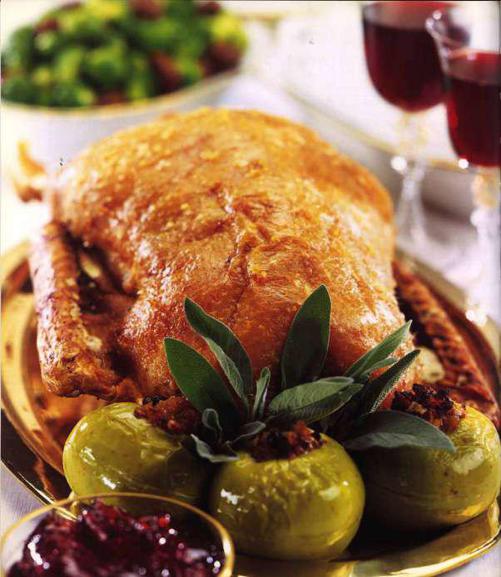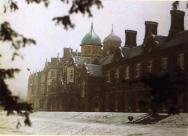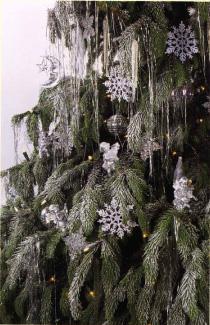In The Royal Manner (24 page)

6.
Melt the remaining butter and gently fry the fennel for 5 minutes until just softened. Add the chopped eggs and cream, and season. Cook, stirring, for a further minute until hot.
7.
Pile the mixture into each bread case, and serve whilst warm with chopped fresh tomato and garnished with reserved fennel fronds and fresh rosemary. Season with black pepper.

The largest Christmas turkey bred in Britain was one which finally weighed 86lb. It was sold for £4,400 at a charity auction in 1989.
Tom Smith was the inventor of the Christmas cracker in the middle of the 19th century.
It is now an essential part of the festivities and can provide an extra element of colour on the Christmas table.

ROAST GOOSE
WITH
BAKED APPLES
AND
SAGE
AND
ONION STUFFING
I hove decided to restore the tradition and show you a delicious recipe for Roost Goose with Sage and Onion Stuffing, as part of my interpretation of a traditional Christmas menu
Serves: 8
Preparation time: 45 minutes plus cooling
Cooking time: approx. 3 hours 15 minutes
5 medium onions
4 tbsp freshly chopped sage or 1 tbsp dried
1 75g/6oz fresh white breadcrumbs
75g/3oz butter
Salt and freshly ground black pepper
4–5 kg/9–11lb oven-ready goose, giblets removed
50g/2oz no-need-to-soak dried apricots, finely chopped
25g/1oz raisins, chopped
25g/1oz walnuts, chopped
1 tsp ground cinnamon
8 small cooking apples
Fresh sage to garnish
Preheat the oven to 200° C/400° F/Gas 6
The first Christmas cards were commissioned and sent by Henry Cole, the founder of the Victoria and Albert Museum, in 1846. However, it wasn't until 1870 that the exchanging of cards became popular with the introduction of a cheaper rate of postage.
1.
First make the stuffing. Peel and roughly chop 4 of the onions, place in a saucepan and pour over 600 ml/1 pt water. Bring to a boil and simmer for 10 minutes until very soft. Then drain well and blend in a food processor until smooth or push through a sieve into a bowl to form a purÉe.
2.
Transfer to a large bowl and stir in the sage and breadcrumbs. Melt 50g/2oz butter and stir into the mixture. Season well and allow to cool.
3.
Next prepare the goose. Pull out the fat from inside the goose cavity and set aside. Prick the skin all over with a fork and then rub with salt.
4.
Spoon the cooled stuffing into the neck cavity of the goose. Any left-over stuffing can be baked alongside the goose in a buttered dish for the last 30 minutes of cooking time. Skewer the neck skin to the back of the bird, and then truss and tie up with string. Weigh the bird and calculate the cooking time at 15 minutes per 450g/1lb plus an extra 15 minutes.
5.
Place the goose on a wire rack above a roasting tin. Cover the breast with the reserved goose fat, and then cover with foil. Bake in the oven for the required time, basting frequently. Remove the foil for the last 30 minutes to allow the goose to brown.
6.
For the baked apples, peel and finely chop the remaining onion, melt the remaining butter and gently fry the onion for 5 minutes until soft. Remove from the heat and stir in the apricots, raisins, walnuts, cinnamon and seasoning.
7.
Core the apples and score the skin around the middle of each. Press the fruity filling into each apple, and place in a baking dish. Place in the oven to cook for the last 30 minutes of roasting time.
8.
Once the goose is cooked, drain and place on a warmed serving platter. Allow to stand for 15 minutes. Arrange the baked apples around the goose, and garnish with fresh sage. Serve with redcurrant jelly.
Cook's tip:
to test to see if the goose is cooked, pierce with a skewer in the thickest part of the leg. If the juices run clear the bird is cooked.
TIPSY RATAFIA TRIFLE
Everyone is familiar with the fruited Christmas Pudding which for some is a rather heavy conclusion to an already rich meal. This traditional Victorian alternative combines the fresh taste of fruit with sweet dessert wine to give it a modern twist. It is an excellent alternative and one which will be popular with all members of your family. It can be made a few hours in advance and will keep for 3 – 4 days.
Serves: 8
Preparation time: 15 minutes plus soaking and chilling
No cooking
6 almond macaroons
2 tbsp raspberry jam
40 ratafia biscuits
4 tbsp dessert wine or sweet sherry
4 tbsp brandy
225g/8oz raspberries, thawed if frozen
4 slices pineapple, peeled and cut into small pieces
1 quantity of Crème
Anglaise
(see page 54) or
750 ml/1 ¼ pt good-quality custard sauce
600 ml/1 pt whipping cream
Gold dragees and frosted rose petals to decorate
1.
Spread the macaroons with raspberry jam and place jam side up in the base of a glass serving bowl. Top with the ratafias and spoon over the wine or sherry and brandy. Set aside to soak for 1 hour.
2.
Spoon over the raspberries and pineapple, and pour over the Crème
Angiaise
or custard sauce. Whip the cream until just peaking and pile over the top. Cover and chill for 30 minutes.
3.
Serve decorated with dragees and frosted rose petals.
Cook's note:
to frost rose petals, wash and dry a few rose petals. Lightly beat an egg white until frothy and dip the petals. Shake off any excess liquid and then sprinkle with caster sugar. Place on sheets of greaseproof paper to dry.
SANDRINGHAM HOUSE
This red-brick, multi-faceted Edwardian building resembles a rather grand shooting lodge. The house has a baronial central hall complete with minstrel gallery, hanging tapestries and an eight-foot-square fireplace. Large house parties, especially shooting parties, can easily be accommodated within its panelled interior.
The Royal Family traditionally spend the festive season here and their daily life is punctuated with shoots, lunches and dinner parties.

Although Queen Victoria preferred the vacational atmosphere of Osborne House on the Isle of Wight, her son Edward VII regularly entertained at Sandringham House. The
Daily Sketch
reported in December 1914 that the Christmas menu at Sandringham would be turkey, goose, baron of beef, pork, cygnet from the Thames, boar's head, mince pies and a flaming plum pudding, ‘which will be carved by the King’. The tenants would have venison given them from the estate.

HISTORY OF THE CHRISTMAS TREE

Although Prince Albert was once credited with bringing the first Christmas tree to Britain, it is now accepted that the Prince made the custom popular as the centrepiece of Christmas festivities. There is a reference to Princess Mary, daughter of Henry VIII, later Mary I, having one Christmas a rosemary bush spangled with gold.
The first mention of a decorated tree, similar to the modern one, is in 1800 when Queen Charlotte, wife of George III, had one at court. The custom came from Germany. Before her marriage Queen Charlotte was the German Princess of Mecklenburg-Strelitz. Martin Luther, the religious reformer, is said to have instigated the custom of Christmas trees in Germany and if so, he was adapting a far older tradition of bringing in greenery-from the wood to neutralize the pagan worship of tree spirits.
Later Queen Adelaide, the wife of William IV, made a large fir tree lit with candles the centre of her Christmas drawing room and this custom was followed in the household of Princess Victoria at Kensington Palace. After her marriage, the Royal Household had several Christmas trees for the Queen, her consort and each of the children. Each of the ladies-in-waiting was also given one. All were lit on Christmas Eve when the presents were given out. Afterwards the candles were put out and not lit again until the evening of Christmas Day. The tallest tree was always placed in the drawing room where the candles could be relit when required, especially on New Year's Eve and Twelfth Night.

